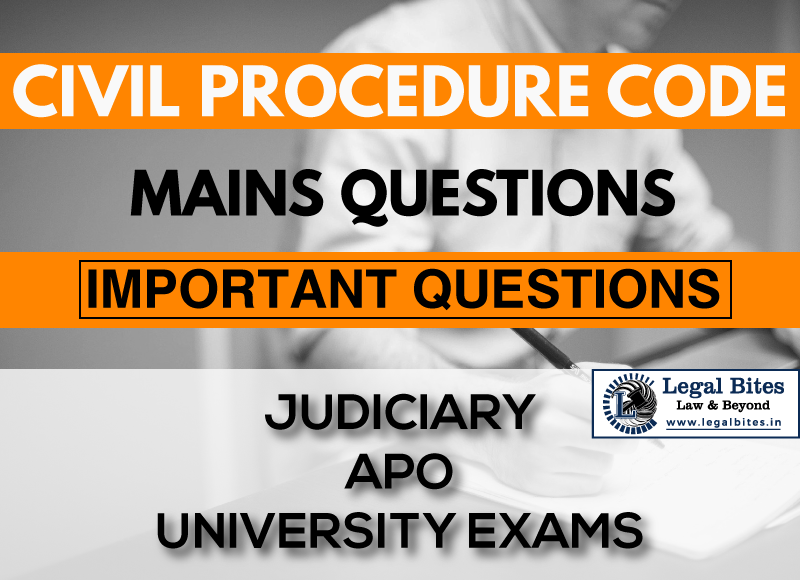Distinguish "Invalid Decree" and "Void Decree". Whether a void decree can be challenged in collateral proceedings, explain.
Find the answer to the mains question only on Legal Bites.

Question: Distinguish "Invalid Decree" and "Void Decree". Whether a void decree can be challenged in collateral proceedings, explain. [RJS 2017]Find the answer to the mains question only on Legal Bites. [Distinguish "Invalid Decree" and "Void Decree". Whether a void decree can be challenged in collateral proceedings, explain.]AnswerThe terms “invalid decree” and “void decree” are used to describe judicial decisions that are defective or invalid in some manner. The difference...
Question: Distinguish "Invalid Decree" and "Void Decree". Whether a void decree can be challenged in collateral proceedings, explain. [RJS 2017]
Find the answer to the mains question only on Legal Bites. [Distinguish "Invalid Decree" and "Void Decree". Whether a void decree can be challenged in collateral proceedings, explain.]
Answer
The terms “invalid decree” and “void decree” are used to describe judicial decisions that are defective or invalid in some manner. The difference between them lies in the nature and extent of the defect, and the legal consequences.
An invalid decree is a decree that suffers from a defect or irregularity that makes it legally insufficient or flawed. The defect may arise from various sources, such as errors in procedure, lack of jurisdiction, non-compliance with statutory or constitutional requirements, fraud, collusion, or mistake. The term “invalid” implies that the decree is not void from the beginning, but rather has a legal flaw that can be cured or corrected by appropriate legal processes, such as appeal, review, revision, or amendment. An invalid decree is binding and enforceable until it is set aside or modified by a competent authority.
An example of an invalid decree is a decree passed beyond the period of limitation. In Bhawarlal v. Universal Heavy Mechanical Lifting Enterprises, [1999] l SCC 558, the Supreme Court held that a decree passed after the expiry of the limitation period was not a nullity, but an error of law, or at the highest, a wrong decision. Such a decree could be corrected in appellate proceedings, and not by the executing court, which was bound by the decree. The Supreme Court observed that the executing court could not go behind the decree and question its validity on the grounds of limitation.
A void decree is a decree that is void ab initio, meaning that it is null and ineffective from the very inception. It has no legal effect or force, and cannot confer any rights or obligations on the parties. A decree may be void for various reasons, such as lack of jurisdiction, violation of natural justice, contravention of public policy, or fundamental illegality. A void decree is treated as a nullity and can be ignored or disregarded by anyone affected by it. It can be challenged and set aside at any stage, even in execution or collateral proceedings, and even by a stranger to the decree.
An example of a void decree is a decree passed by a court that has no territorial jurisdiction to entertain the suit. In Vivek Purwar and Anr. v. Hari Ram & Sons, [2022/DHC/004630], the Delhi High Court returned the plaint to the plaintiff, as the trial court had no territorial jurisdiction to decide the suit. The High Court also set aside the findings of the trial court on other issues and held that they would not be binding on the parties, in view of the lack of territorial jurisdiction of the court.
A void decree can be challenged in collateral proceedings, which are legal actions that are brought outside the original case that resulted in the void decree. Since a void decree is null and has no legal effect, it can be challenged at any time, even after the expiry of the limitation period, and even in a subsequent case or through a collateral attack. The grounds for challenging a void decree may vary, depending on the nature and extent of the defect, but they usually include lack of jurisdiction, violation of due process, or infringement of constitutional rights.
An example of challenging a void decree in collateral proceedings is a case where a decree is passed by a court without jurisdiction. In Kiran Singh & Ors. v. Chaman Paswan & Ors., [1955] l SCR 117 the Supreme Court declared:
a decree passed by a court without jurisdiction was a nullity, and that its invalidity could be set up wherever and whenever it was sought to be enforced or relied upon, even at the stage of execution and even in collateral proceedings. The Supreme Court further stated that a defect of jurisdiction struck at the very authority of the court to pass any decree, and that such a defect could not be cured even by consent of parties.
Important Mains Questions Series for Judiciary, APO & University Exams
- CPC Mains Questions Series: Important Questions Part – I of X
- CPC Mains Questions Series: Important Questions Part – II of X
- CPC Mains Questions Series: Important Questions Part – III of X
- CPC Mains Questions Series: Important Questions Part – IV of X
- CPC Mains Questions Series: Important Questions Part – V of X
- CPC Mains Questions Series: Important Questions Part – VI of X
- CPC Mains Questions Series: Important Questions Part – VII of X
- CPC Mains Questions Series: Important Questions Part – VIII of X
- CPC Mains Questions Series: Important Questions Part – IX of X
- CPC Mains Questions Series: Important Questions Part – X of X

Mayank Shekhar
Mayank is an alumnus of the prestigious Faculty of Law, Delhi University. Under his leadership, Legal Bites has been researching and developing resources through blogging, educational resources, competitions, and seminars.
